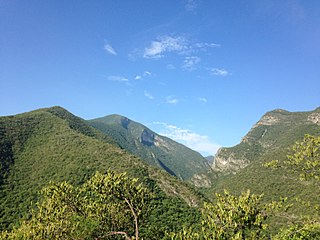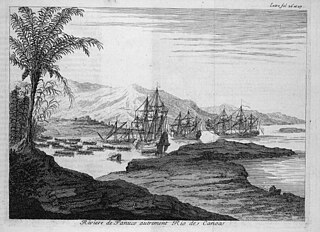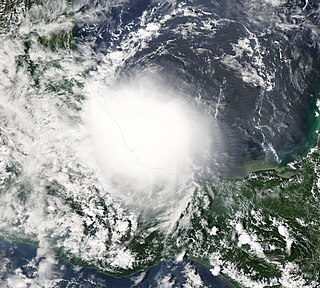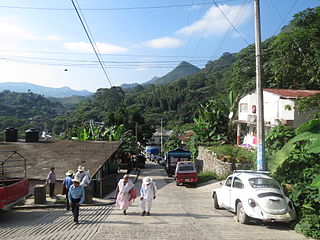See also
| Wikimedia Commons has media related to Río Pantepec . |
| Pantepec River | |
|---|---|
| Location | |
| Country | Mexico |
The Pantepec River is a river of Mexico that belongs to the Tuxpan River basin, on the Gulf of Mexico slope. The Pantepec River is considered the upper course of the Tuxpan River.
The Pantepec River begins in the mountains of the state of Hidalgo, it crosses the Sierra Norte de Puebla, enters the state of Puebla and goes down to the Gulf Coastal Plain in the state of Veracruz. After converging with the Vinazco River, it becomes known as Tuxpan, and ends up flowing into the Gulf of Mexico at the municipality of Tuxpan, Veracruz.
The river is about 130 kilometers long. It is formed by the springs of the eastern slope of the Sierra Madre Oriental, and along its course towards the Gulf of Mexico it receives the waters of numerous tributaries in the Sierra Norte of Puebla. Due to the great rainfall in this river basin, during the rainy season it usually suffers floods, some of which have caused great social disasters. In October 1999, the Pantepec River swept away several houses in the municipality of Huehuetla, Hidalgo, and 254 people in the state of Puebla. When the Pantepec overflows, the soft soils of the Sierra Norte break away from the mountain slopes, and this endangers its inhabitants, especially between the months of June and October, when the rains are highest in the region.
| Wikimedia Commons has media related to Río Pantepec . |

Veracruz, formally Veracruz de Ignacio de la Llave, officially the Free and Sovereign State of Veracruz de Ignacio de la Llave, is one of the 31 states which, along with Mexico City, comprise the 32 Federal Entities of Mexico. It is divided into 212 municipalities, and its capital city is Xalapa-Enríquez.

Puebla, officially Free and Sovereign State of Puebla, is one of the 32 states which comprise the Federal Entities of Mexico. It is divided into 217 municipalities and its capital is the city of Puebla.

Poza Rica, formally: Poza Rica de Hidalgo is a city and its surrounding municipality in the Mexican state of Veracruz. Its name means "rich well/pond". It is often thought that the name came to be because it was a place known for its abundance of oil. In reality, before oil was discovered, there existed a pond rich in fish, which gave origin to the city’s name. In the last century oil was discovered in the area. It has since been almost completely extracted. This has resulted in the decline of oil well exploration and drilling activities, though there are still many oil facilities.

The Sierra Madre Oriental is a mountain range in northeastern Mexico. The Sierra Madre Oriental is part of the American Cordillera, a chain of mountain ranges (cordillera) that consists of an almost continuous sequence of mountain ranges that form the western "backbone" of North America, Central America, South America, and Antarctica.

The Pánuco River, also known as the Río de Canoas, is a river in Mexico fed by several tributaries including the Moctezuma River and emptying into the Gulf of Mexico. The river is approximately 510 kilometres (320 mi) long and passes through or borders the states of Mexico, Hidalgo, Querétaro, San Luis Potosí, Tamaulipas, and Veracruz. According to the Atlas of Mexico, it is the fourth-largest river in Mexico by volume of runoff, and forms the sixth-largest river basin in Mexico by area.

Totonacapan refers to the historical extension where the Totonac people of Mexico dominated, as well as to a region in the modern states of Veracruz and Puebla. The historical territory was much larger than the currently named region, extending from the

Cuetzalan is a small town set high in the hills in the north of the Mexican state of Puebla, 183 kilometres (114 mi) from Puebla, the state capital.

The Necaxa River is one of the main rivers of the Mexican state of Puebla. It is a tributary of the Tecolutla River. Beginning south of Huauchinango with the name Totolapa, it runs through tall mountains and deep canyons of the Sierra Madre Oriental, forming the waterfalls known as Salto Chico y Salto Grande. Its flow is also used to generate hydroelectric power.

La Huasteca is a geographical and cultural region located partially along the Gulf of Mexico and including parts of the states of Tamaulipas, Veracruz, Puebla, Hidalgo, San Luis Potosí, Querétaro and Guanajuato. It is roughly defined as the area in which the Huastec people had influence when their civilization was at its height during the Mesoamerican period. Today, the Huastecs occupy only a fraction of this region with the Nahua people now the most numerous indigenous group. However, those who live in the region share a number of cultural traits such as a style of music and dance, along with religious festivals such as Xantolo.

The Sierra Madre de Oaxaca is a mountain range in southern Mexico. It is primarily in the state of Oaxaca, and extends north into the states of Puebla and Veracruz.

The Sierra Madre Oriental pine–oak forests are a Temperate broadleaf and mixed forests ecoregion of northeastern and Central Mexico, extending into the state of Texas in the United States.

Hurricane Lorenzo was a rapidly developing tropical cyclone that struck the Mexican state of Veracruz in late September 2007. The twelfth named storm and fifth hurricane of the 2007 Atlantic hurricane season, it formed in the southwestern Gulf of Mexico from a tropical wave. After meandering for two days without development, the storm began a steady westward track as its structure became better organized. In an 18‑hour period, Lorenzo's winds increased from 35 mph (55 km/h) to 80 mph (130 km/h), or from a tropical depression to a hurricane. On September 28 it struck near Tecolutla, Veracruz, a month after Hurricane Dean affected the same area, before it quickly dissipated over land.

The Sierra Norte de Puebla is a rugged mountainous region accounting for the northern third of the state of Puebla, Mexico. It is at the intersection of the Trans-Mexican Volcanic Belt and the Sierra Madre Oriental, between the Mexican Plateau and the Gulf of Mexico coast. From the Mesoamerican period to the 19th century, this area was part of a larger region called Totonacapan, and area dominated by the Totonac people, extending further east to the Gulf of Mexico. Political maneuvers to weaken the Totonacs led to the region being divided between the modern states of Puebla and Veracruz with the Puebla section given its current name. Until the 19th century, the area was almost exclusively indigenous, with the four main groups still found here today, Totonacs, Nahuas, Otomis and Tepehuas, but coffee cultivation brought in mestizos and some European immigrants who took over political and economic power. While highly marginalized socioeconomically, the area has been developed heavily since the mid 20th century, especially with the building of roadways linking it to the Mexico City area and the Gulf coast.

In October 1999, severe flooding affected portions of eastern Mexico and Central America. Rainfall in September preceded the primary event in Mexico, which moistened soils. On October 4, Tropical Depression Eleven developed in the Gulf of Mexico, which drew humidity from the gulf and the Pacific Ocean to produce torrential rainfall in mountainous regions of eastern Mexico, reaching 43.23 in (1,098 mm) in Jalacingo, Veracruz. This was the third-highest tropical cyclone-related rainfall total in Mexico from 1980–2006, and the event caused the highest rainfall related to tropical cyclones in Veracruz, Hidalgo, and Puebla. In some locations, the daily rainfall represented over 10% of the annual precipitation total. The heaviest rainfall occurred in mountainous regions that were the mouths of several rivers. A broad trough absorbed the depression on October 6, and rainfall continued for the next few days. Additional rainfall occurred in Tabasco state on October 18. The floods were estimated as a 1 in 67 year event in one location, although such floods are expected to affect eastern Mexico twice per century, the last time being 1944.

The Tuxpan River in Mexico flows into the Gulf of Mexico near the city and port of Tuxpan in the state of Veracruz. Its principal sources are the Vinazco River, which rises in Hidalgo, and the Pantepec River, which rises in Puebla, both of which enter the territory of Veracruz before the city of Álamo, in Temapache Municipality, uniting to form the Tuxpan, which has become an important passage for harbor access, strengthening the region's economy. Passing the city of Tuxpan it forms the lagoon of Tampamachoco close to its mouth.

Pahuatlán, officially Pahuatlán del Valle, is a town and municipality located in the northwest of the state of Puebla in central Mexico. The municipality is part of the Sierra Norte region of the state, a steep mountainous area which receive significant moisture from the Gulf of Mexico, and borders the states of Hidalgo and Veracruz.

The Cuenca del Papaloapan Region is in the north of the state of Oaxaca, Mexico where the foothills of the Sierra Madre de Oaxaca meet the coastal plain of Veracruz. The principal city is San Juan Bautista Tuxtepec, the second largest in Oaxaca state.

The Tecolutla River is a river in the state of Veracruz in Mexico, and the main drainage of the historical and cultural region of Totonacapan. It is principally fed by four rivers that rise in the Sierra Norte de Puebla: from north to south, they are the Necaxa, the Lajajalpan, the Tecuantepec and the Apulco. These rivers converge in the municipality of Espinal, Veracruz, and from here the Tecolutla flows about 100 kilometres (62 mi) east through the coastal plain and the municipalities of Papantla and Gutiérrez Zamora to its mouth at the town of Tecolutla on the Gulf of Mexico, On its south bank the Tecolutla receives the Joloapan River near Paso del Correo, and the Chichicatzapan River via the Ostiones estuary near its mouth.

Huehuetla is a rural municipality in Puebla, Mexico.

The Tepehuas are an indigenous people of Mexico whose name means in Nahuatl, "people of the mountain", although they refer to themselves without a term or name that encompasses a supposed ethnic group. They also use endoethnonyms that originate in Spanish-influenced Nahuatl: